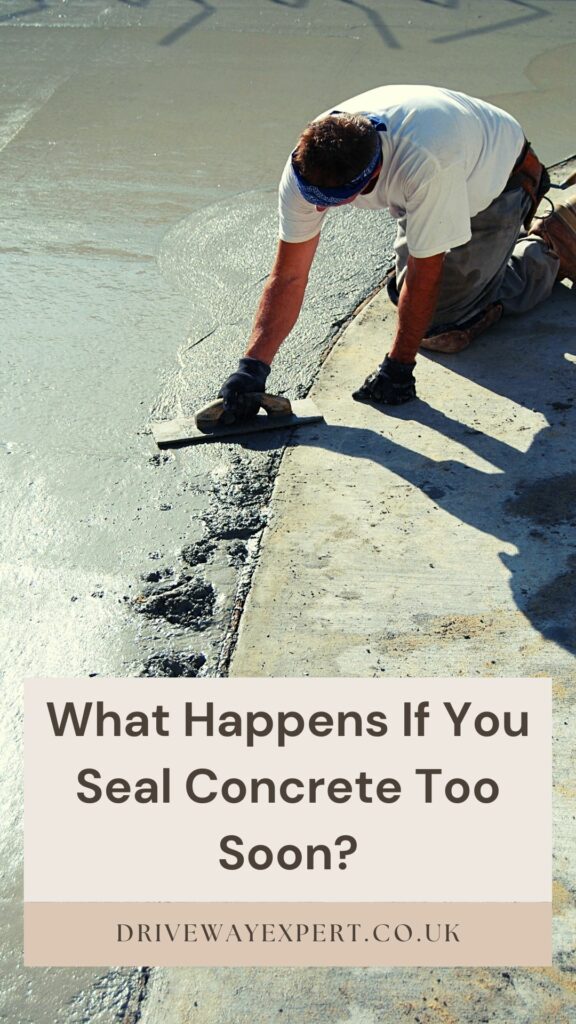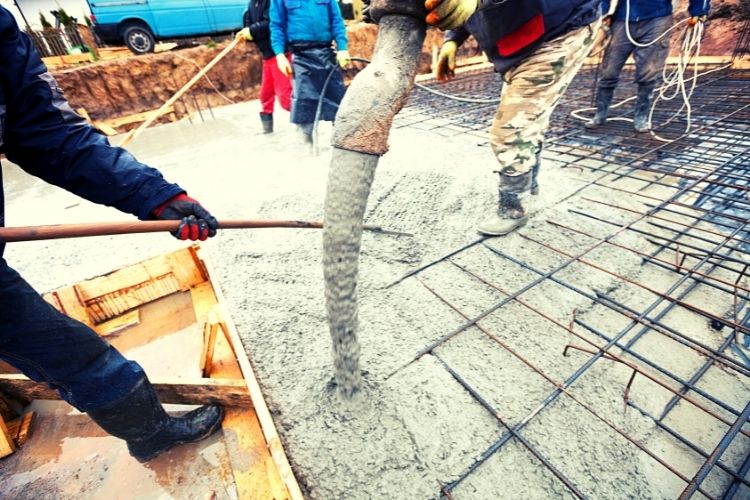If you have recently installed a concrete driveway, then you’ve probably heard that sealing it is a good move. But it’s really important not to get ahead of yourself as sealing your concrete too soon after installation can do more harm than good.
Sadly, this is a common mistake made by one too many homeowners and it’s not the only problem people are having. So, we have created this guide that tells you what happens if you seal concrete too soon and will help you make sure that your installation goes according to plan.

Table of Contents
Why Do You Need To Seal Concrete?
Let us start by saying that you don’t have to seal your concrete but we’d highly recommend that you do. You will need to wait at least 28-30 days, but some people choose to leave it six months before sealing concrete.
However, regardless of when you do it, sealing concrete helps to protect it in more ways than one. For starters, the sealant will ensure that the concrete can resist absorbing water which would otherwise cause it to deteriorate much more quickly and potentially become damaged.
Moreover, a sealed concrete driveway won’t experience as much cracking nor will it be as prone to damage from freezing and thawing or salt. You’ll also notice that the aesthetic appearance of your concrete will be much better when it is sealed. It’ll be more resistant to stains, mould and efflorescence.
Once your concrete is fully cured, there are several different types of sealant that you might choose. Which you go for will depend on the type of protection you want and how often you’re willing to repeat the process. Silicate sealers are great if you’re looking to increase the strength of the structure whereas a water repellent product is much better when trying to prevent damage from freezing and thawing.
Why Can’t I Seal Concrete Straight Away?
Concrete is made from several ingredients including cement, water and sand or gravel. The ratios of these materials are essential if you want to get the right consistency and what you end up with should be something that is easy to pour and smooth out. Moreover, when concrete is mixed correctly, it’ll cure much more effectively meaning a better and stronger end result.
But even once the concrete is cured, it’s still going to absorb water and other liquids such as oil. This can affect the quality of the concrete and shorten its lifespan. But that’s why it’s important to seal the concrete as it can protect against this and many other things, as we have already discussed.
But it is super important to make sure that the concrete has plenty of time to cure. It can be tempting to add the sealer sooner with the belief that you’ll be protecting the surface. But adding it too soon can do more harm than good.
Generally speaking, concrete takes around 30 days to completely cure. This means that it can be walked on and used in other ways without the risk of damage. But you must also wait this length of time before adding any sealer because, if you do, there is a very real risk of ruining the future strength of the driveway.
This is because, while the concrete is still curing, there is a lot of excess moisture in it. This needs to evaporate. But if you apply a sealer over the top of the concrete, this moisture has nowhere to go and so it’ll remain stuck inside the structure. Over time, the moisture will cause damage and decrease the strength of your driveway.
What’s more, you’ll find that the driveway is far less resistant to things like cracking if you apply sealer too soon after installation.
Other Common Mistakes When Sealing Concrete
Many people unintentionally apply sealer too soon thinking that they’re doing the concrete a favour, when in reality, they’re not. But this isn’t the only thing that homeowners get wrong, especially during their first concrete installation.
If you want to avoid having any issues down the line then we would suggest reading the following common concrete sealing mistakes.
- Not cleaning the concrete first. It is super important to make sure that you clean the concrete and remove any debris before applying the sealer. If you don’t, this could affect its quality and cause staining especially from things like leaves.
- Not choosing the right sealant. If you have never purchased a concrete sealer before, you could be forgiven for thinking that they’re all one of the same thing but this is not the case. For example, you might choose a sealer with a glossy finish but if you’re looking to protect from stains, this isn’t going to be the best product.
- Not providing good aftercare. If you think that applying the sealer is the last step then you’re mistaken. Even after this, you’ll need to make sure that you take good care of your driveway if you want it to perform at its best. Sealer doesn’t last forever so you’ll need to schedule regular reapplications.
How To Effectively Seal Concrete
So, now that we understand some of the most common mistakes when sealing a new concrete driveway, let’s get to grips with the best way to apply it. Adding a sealant to your concrete driveway isn’t difficult and if you follow these steps, you’ll get the best protection that stands the test of time.
Cleaning The Concrete
Before you do anything else, it is vital that you clean your concrete surface. If you don’t, then any dirt or debris could result in staining or discolouration. What’s more, there may be some types of debris that could result in cracking so it’s best to tackle this first.
Depending on what debris is present, you might need to use different cleaning methods. For the most part, giving the driveway a good sweep with a broom should be enough. However, you may need to use water from the garden hose to get rid of any stubborn debris. While it is possible to use a pressure washer, we wouldn’t recommend this unless it’s absolutely essential and the pressure could damage the concrete. If you have to use one, keep the pressure low and hold the nozzle as far away from the concrete as possible.
We would suggest doing this on a warm, dry day as this will allow the concrete to dry off completely. You should not apply sealer while the concrete is still wet.
Choosing The Correct Sealer
As we have already discussed, there isn’t only one type of driveway sealer and choosing the right one is imperative.
Some sealers will improve the aesthetics of your driveway giving it a glossy appearance. But there are others that can help prevent stains and some which come with various benefits. It’s a good idea to think about what you want to achieve with the sealer and what risks are most likely to affect the concrete. This will help you make the right decision.
We should point out that, even though there are professional sealing services, a lot of people decide to do the job themselves. That’s OK but you want to make sure that you buy a professional quality sealer and not just a general product as the quality won’t be as good.
Applying The Sealer
When it comes to actually putting the sealer onto the concrete, you will need to think about how you’re going to do this. Rolling the sealer onto the concrete is a very popular method as it is one of the quickest and most convenient. What’s more, using a roller ensures that you get a very even finish and good coverage.
That said, it is also possible to brush the sealer on although you should keep in mind that this is much more time consuming. If you have a bigger driveway, it’s probably best to avoid this method.
However, if you want something really quick and efficient, then you’ll likely want to spray the sealer onto the concrete. You’ll get even coverage that is far superior to anything else and it’ll be done in no time.
Letting Everything Dry
You had to wait for the concrete driveway to cure before applying the sealer but now you have applied it, you’ll have to wait for this to dry as well. However, you won’t be waiting for quite as long as sealer usually doesn’t take more than around 24 hours to dry.
During this time, we would advise not using the driveway for walking, parking or anything else. After the 24 hours has passed, you should check the sealer to make sure it is properly dry. This also gives you an opportunity to make sure you haven’t missed any spots and touch them up if necessary.
Caring For Your Concrete After Sealing
After you have sealed your driveway, it’s really important that you take good care of it if you want the protection to last. One of the simplest ways to do this is by cleaning the driveway regularly. This involves sweeping away any debris and spraying the driveway with water. As before, we wouldn’t recommend using high pressure.
When you use a pressure washer on concrete that has been sealed, there is a risk of removing the sealer and therefore, the protection. However, you may occasionally get spills on the driveway from things like oil and it’s important to remove these as soon as possible. If you cannot do this yourself, there are plenty of professional exterior cleaning services that will do it for you.
Also note that you will need to reapply your sealer from time to time. Different products will last different lengths of time but generally speaking, your sealer should be good for around two years.
Conclusion
Concrete is a hugely popular material for driveways and other outdoor structures. However, if it isn’t properly cared for, it won’t perform as you expect. One of the most important things is to seal the concrete to protect it from water damage, traffic, stains and other things.
But it’s incredibly important not to apply the sealer too soon. If you do, you’ll trap excess moisture inside the concrete which will cause damage over time. You should always wait around 30 days for the concrete to cure before applying sealer.


